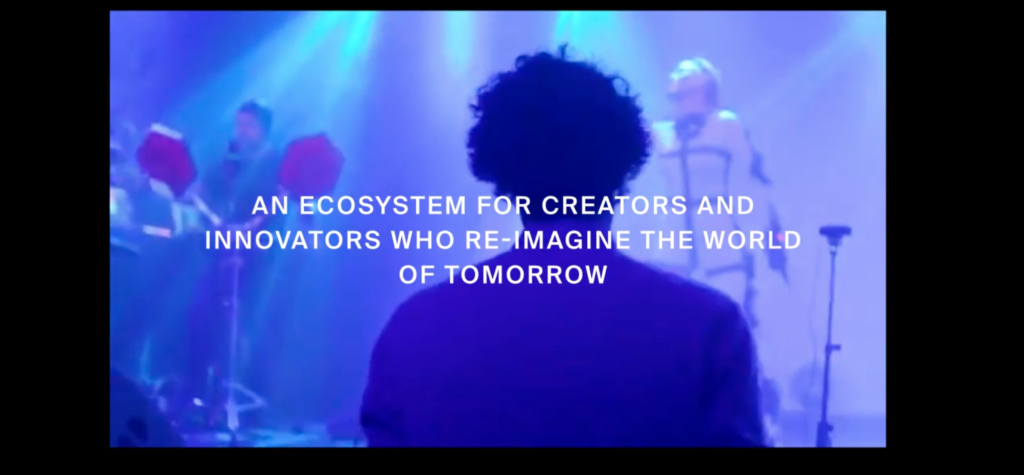
Is the end of the traditional large law firm model here? That was the main thought Artificial Lawyer came away with after speaking recently to the team behind the Freshfields Lab at Berlin’s super cool Factory innovation space.
It’s a big question, which deserves some unpacking. So, first, what do we mean by a traditional large law firm? It has meant a business that predominately provides legal advice. That sounds simple enough, until one considers the myriad ways those legal needs are met by a large, modern commercial law firm.
However, whether we are talking about process work, day to day BAU work, or bet the company advice, or simply holding the client’s hand through a very complex matter, it’s all about producing legal outcomes for a client, from drawing up contracts, to reviewing them, to litigating them and everything in-between.
But, what if a leading commercial ‘law firm’ now had to do more than law to prosper and keep clients happy?
And, it’s worth saying that just because we now have ALSPs, LPOs, law companies and the Big Four in the market, it does not automatically mean the traditional model that has existed for centuries is over. They can all co-exist in parallel. One species’ evolution does not mean every other species has to evolve as well to survive. Nature doesn’t work like that.
Also, just because a number of law firms in the UK have become Alternative Business Structures (ABS) under the Legal Services Act and started to make a handful of other professionals into equity partners, also does not mean the trad model is over. A CFO and some accountants made into partners, or even a public listing, does not make the overall business model of a firm that different in terms of what it sells.
It’s also worth saying that the majority of the ‘true’ ABSs in the UK that are genuinely offering a wide combination of law and other professional services, such as property surveying and accounting, are very small firms. In fact, the majority of the now 100s of ABSs in the UK are very, very small, no matter what they offer. [Note: England & Wales has around 10,000 registered ‘law firms’, most under £10m in revenue.] We are talking about the largest commercial legal brands here, i.e. what is called ‘Big Law’ in the US.
The trad model is only really over when the leading firms, in growing numbers, invest significantly in offering more than law.
Also this is not about ownership structures, but rather what is made by that business and sold to the clients.
And it looks like that there are now so many large law firms offering ‘more than law’ – primarily around technology-related solutions – that it seems fair to ask whether the trad model is actually over and how we would gauge that?
–

Freshfields and Many Others
AL spoke with Isabel Parker, Chief Innovation Officer at Freshfields, and Felix Netzer and Gerrit Beckhaus – both lawyers at the firm in Germany about the firm’s new venture. Together they, among others, are playing a key role in steering the development of the Lab, as it’s called.
But first, what is the Lab? In a nutshell it’s a place where the firm’s lawyers; tech, innovation and process professionals; and their clients, can all come together and build solutions to meet real and specific needs.
In short, it’s a ‘collaborative engineering consultancy’, one could say. It’s a capability the law firm, which can trace its roots back to 1743, is offering to clients to do two things: 1) help to make money for the firm – naturally, and 2) to make the clients happy by solving problems that go beyond legal advice so those clients stick with the firm and keep coming back for more.
And perhaps the second bit is the key part here. And that’s where it is starting to feel like things could be changing. Not that Freshfields is the first firm to build tech-based applications to help clients, or build them with clients. From DWF to Clyde & Co to Clifford Chance to Linklaters to BCLP to Eversheds to Reed Smith, a range of firms have moved beyond giving just ‘legal advice’, or even just handling legal needs, whether process level or otherwise.
Let’s take the example of what Freshfields is doing. When asked what they are building at the Lab the answer is ‘digital solutions’. One project they have worked on covers mass claim proceedings in Germany. This, the team explains is a data co-ordination exercise. It’s a tech project. It may be intimately part of a client’s legal needs, but the actual ‘product’ is tech and process and data. That’s not legal advice.
They’ve been deploying a range of tech and process refinements on other matters. They’ll be using doc automation tools, and/or AI review tools like Kira Systems, or other tech. Much of it is about data flows, analysis, shaping a product and creating a ‘tool’ (or we could say a ‘software machine’) that performs a task the client wants or needs.
Again, this is not legal work, this is engineering consulting – but for the 21st century professional services world. (You could call it legal engineering too, but maybe we can just drop the ‘legal’?)
Parker explains: ‘We are adding value. We are always looking to add value to the technology.’
I.e. this is not just about wheeling out some tech they’ve bought, but shaping a product for the clients. They are not ‘lending a hammer’ to a neighbour, they are helping the neighbour with the creation of a whole new device to do a task, which may well need the hammer to make it.
Another project they’ve done is building better graphical representations of the data output from AI-driven doc reviews. They’re taking the tech and building a tool (software machine) that turns data into something more easy to understand for the client, that can reveal deeper insights and show patterns. Again, this is not legal work.
AL asks: ‘Is this consulting?’
Parker replies: ‘It is almost like that. We know our clients well, and they trust us, so we can help them [with these needs].’
Netzer adds: ‘Our clients are excited about this [tech offering], they are up for it. And you can see a cultural change within the clients.’
While Beckhaus goes on to explain: ‘There is a lot to learn from the startups here at the Factory. One thing that happens here is that there are reverse pitches where a corporate pitches to the startups and then they critique the corporate.’
And who would ever have thought that a global law firm that traces its roots back to 1743 would feel inspired by feedback from a bunch of tech startups? Or that clients actively want tech solutions crafted by the same people who give them their legal input? Something has clearly changed.
But, How Much Has It Changed?
Clearly there is some change. There is a move by some major firms to do more than law. But, the $700 billion question is: how much? Is this just a little outcrop, a tiny promontory of specialist consultancy that acts almost as a ‘value add’ offering, but it’s not really strategically pivotal to success, nor will ever grow?
Does selling small amounts of engineering consulting services mean we are looking at a new business model? Or is it still very much the same old business model with a little nodule of tech attached at the side. A little mole on the grand face of Big Law?
Also, is this really any different to what has come before?
Law firms have long toyed with consulting. Some still offer a range of consulting services, from lobbying services (in the US, especially in Washington DC), to super niche advisory around reinsurance that goes beyond pure legal advice. Other firms get so involved in corporates’ public relations spats that it’s hard to see some of their work as ‘legal’.
At first glance it looks like the picture is murky. Where do you draw the line? But, there does seem to be an answer. There’s a difference between advisory and lobbying services, and building software products. That is a very different kind of ‘shop’.
OK, but, as noted, this is all still small potatoes, isn’t it? Even if these engineering consulting businesses are very high quality, are they not just a drop in the ocean of a large firm’s balance sheet? And even if they do engender good will, would Lloyds Bank, for example, walk away from a major law firm just because that firm didn’t or couldn’t help with the design and building of a tech solution for the in-house legal team…?
At present it seems unlikely that clients will leave if you don’t have this.
But, maybe clients will stick around more if you do.
So, this would appear to be a great sign of positive change, of proactive opportunity-taking that helps a law firm to improve its market position. It may be a ‘tweak’ to the offering, but it could be a very compelling one.
Conclusion
Much as it would be great to say the trad model is over for Big Law. It’s not yet.
Some engineering consultancies, attached to Big Law firms, focused on selling products, do not mean the end of the old ways in their entirety. Legal services are still 99% of what the Big Law ‘shop’ sells.
But, if the engineering consultancy offering started to be seen as vital? If it was essential as having a litigation team?
That could be a different story. If clients are literally walking away when you don’t offer this kind of service then that will be a sea change. When the revenue tied up in such teams’ work moves from a small percentage to a truly large number – whether because of direct sales, or from the value created in cementing client relationships – then that will also be a sea change.
We are not there yet. The old DNA of the Big Law trad model is still very much the dominant force.
However, what is happening now does point the way to a very different evolutionary path for the world’s leading law firms – if they were to choose to take it.
—
By Richard Tromans, July 2019, Founder, Tromans Consulting (and Editor, Artificial Lawyer).
A well-written piece Richard, that lays out potential scenarios well.
Michael Ovitz at CAA talent agency and Ben Horowitz and Marc Andreessen at their eponymous early-stageVC firm altered their respective industry’s business models. They did so by bringing allied professionals into their firms to supplement their firms’ core service offerings. In the Andreessen Horowitz case, and at the “cost” of lower draws for the “pure” VC partners, the firm brought on highly paid HR, marketing and sales, engineering, management experts to offer more than traditional “smart money” advice to the early-stage startups in which the firm invested. Law firm clients frequently complain that their law firms “don’t get” (understand) their clients’ businesses. Imagine, then, if BigLaw law firms brought on experienced (and very well paid) professionals in accounting, finance, operations, management , HR, not only to advise the law firms’ clients in these areas of business (as a management consulting firm could), but also to work cheek-by-jowl with (and advise) the firms’ very own lawyers so as to increase the likelihood that the legal advice those lawyers provide lines up far more closely with the now-better-understood business objectives of the firms’ clients.